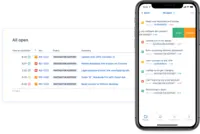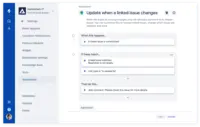Jira Service ManagementFormerly Jira Service Desk
Overview
What is Jira Service Management?
Jira Service Management (formerly Jira Service Desk, now including features from the former Mindville Insight, acquired by Atlassian in June 2020) is a service desk software that is purpose-built for IT, service, and support teams. The software provides everything IT…
Beware JIRA ITSM pricing increase.
Modern and Easy to collaborate ITSM tool
A Great Way to Manage your Tickets
A Few Tweaks, Or Ability To Tweak, Would Make This Product Great To Work With
Jira helps keep your team organized
In depth project management tool
IT Issues Goodbye!
Perfect management and centralized system service
Best Service I Ever Used
JIRA: The tool for immediate support
Jira
Great tool for project management and task-tracking
A Solid Product for internal-use Jira Service Desks across Departments
Modern simple service desk sofware that anybody can use
One stop for all of your service desk issues
Awards
Products that are considered exceptional by their customers based on a variety of criteria win TrustRadius awards. Learn more about the types of TrustRadius awards to make the best purchase decision. More about TrustRadius Awards
Popular Features
- Organize and prioritize service tickets (74)8.383%
- Service-level management (67)8.282%
- Change requests repository (63)7.373%
- Self-service tools (68)7.272%
Reviewer Pros & Cons
Pricing
Free
$0
Standard
$20
Premium
$40
Entry-level set up fee?
- No setup fee
Offerings
- Free Trial
- Free/Freemium Version
- Premium Consulting/Integration Services
Features
Incident and problem management
Streamlining ticketing and service restoration processes
- 8.3Organize and prioritize service tickets(74) Ratings
Prioritize tickets to ensure most urgent are tackled first
- 9Expert directory(2) Ratings
Directory of IT and businesses services available to customers to help route tickets to appropriate subject matter experts
- 9.5Service restoration(2) Ratings
Impact assessment and automated fixes for common problems
- 7.2Self-service tools(68) Ratings
Repository of information documenting common issues and known resolutions which can be accessed directly by users
- 10Subscription-based notifications(1) Ratings
Users subscribe to notifications for ticket updates
- 7.7ITSM collaboration and documentation(61) Ratings
Issue resolution through collaboration mechanisms like discussion threads, social tools; agents can attach notes, files, etc. to tickets in order to maintain a record of all interactions related to the case.
- 5.8ITSM reports and dashboards(62) Ratings
Reports and dashboards are used to optimize service desk operations by supplying key performance and capacity data
ITSM asset management
Managing all IT assets and enforcing policy rules
- 10Configuration mangement(1) Ratings
Database for tracking and reporting all business assets
- 10Asset management dashboard(1) Ratings
Dashboard showing organization's software portfolio
- 10Policy and contract enforcement(1) Ratings
Ensuring that requesters have eligibility before fullfullment
Change management
Ensuring standardized processes for making changes to IT infrastructure
- 7.3Change requests repository(63) Ratings
Single repository of all planned changes and releases
- 6.5Change calendar(2) Ratings
Calendar showing change schedule to stakeholders
- 8.2Service-level management(67) Ratings
Process for negotiating agreements regarding service level expectations, and ensuring these are met
Product Details
- About
- Competitors
- Tech Details
- FAQs
What is Jira Service Management?
Jira Service Management Features
Incident and problem management Features
- Supported: Organize and prioritize service tickets
- Supported: Self-service tools
- Supported: ITSM collaboration and documentation
- Supported: ITSM reports and dashboards
Change management Features
- Supported: Change requests repository
- Supported: Service-level management
Additional Features
- Supported: Custom reporting
- Supported: Self-service Help Center
- Supported: Automation rules
- Supported: ITIL-certified
- Supported: Email support
- Supported: Pre-built workflows
- Supported: SLA's
- Supported: CSAT reporting
- Supported: Asset management integration
Jira Service Management Screenshots
Jira Service Management Competitors
Jira Service Management Technical Details
| Deployment Types | Software as a Service (SaaS), Cloud, or Web-Based |
|---|---|
| Operating Systems | Unspecified |
| Mobile Application | Apple iOS, Android |
| Supported Languages | English, French, Spanish, German, Portuguese (Brazil), Portuguese (Portugal), Russian, Korean, Japanese, Norwegian, Polish, Chinese, Czech, Danish, Dutch, Estonian, Finnish, Hungarian, Icelandic, Romanian, Slovak, Swedish, Vietnamese |
Frequently Asked Questions
Comparisons
Compare with
Reviews and Ratings
(622)Community Insights
- Business Problems Solved
- Pros
- Cons
- Recommendations
Jira Service Desk is a versatile ticketing system that has become the primary solution for managing requests and communication within our organization. It effectively addresses the challenge of handling a large volume of requests and provides a centralized platform for storing and accessing information. Users have found it valuable due to its customizable nature, allowing it to adapt to the specific needs of different departments.
With Jira Service Desk, multiple departments across the organization, such as Client Service, Financial Service, and Tech Engineering, efficiently handle ticketing and tracking tasks. It replaces legacy tools with limited reporting capabilities, facilitating improved processes and workflows. The user-friendly interface makes it easy for both technical and non-technical individuals to navigate and utilize the system effectively.
Jira Service Desk streamlines communication by providing users with an intuitive platform to view and update their tickets easily. It improves transparency among teams by tracking SLA metrics, utilization, incidents, trends, and other key performance indicators. Additionally, Jira Service Desk serves as a documentation tool for projects, enabling the tracking of incoming issues or requests.
By utilizing Jira Service Desk, organizations can streamline internal and external requests and complaints while reducing resolution time. Its efficient helpdesk ticketing system simplifies collaboration between teams and departments. With its customizable workflows and integration with other software tools, Jira enables teams to manage workloads, pre-plan tasks, track progress, assign tickets to team members, and ensure efficient delivery.
Overall, Jira Service Desk is widely used across organizations to improve efficiency in various departments such as IT support, HR, Accounting, Marketing, Sales, and Service Delivery. Its flexibility in customizing workflows allows teams of any size to configure the system according to their specific needs while providing a central location for issue tracking and project management.
Sufficient Communication and Accountability Features: Users have appreciated the tool's sufficient communication and accountability features, which have prevented replication of tasks and decisions. This has eliminated the need to constantly bother the project lead for updates and allowed for easy tracking of completed tasks and discussions.
Versatile Task Management Options: Many users have found the task management options in the tool to be versatile and suitable for a variety of use cases. This feature helps in keeping everyone accountable and ensuring that tasks are completed on time.
Usefulness of BigPicture - Gantt Feature: The BigPicture - Gantt feature has been highly praised by users as it allows them to break down large projects, track multiple phases, and identify where most of their time is spent.
Complicated User Interface: Many users have found the user interface of JIRA Service Management to be complicated, not intuitive, and difficult to navigate. Some users have experienced difficulty in understanding and utilizing certain features of JIRA Service Management, even after using it for an extended period.
Steep Learning Curve: Several reviewers have mentioned a steep learning curve associated with JIRA Service Management. They have expressed that it takes significant time and effort to understand and set up workflows, requiring dedicated administrators which adds to the cost and overhead.
Limited Customization Options: Users have reported limited customization options for the customer portal in JIRA Service Management. This limitation makes it difficult for organizations to meet specific branding and design requirements.
Users have made several recommendations based on their experiences with JIRA. The most common recommendations include considering using JIRA if already using other Atlassian products, trying a free trial or demo before implementing JIRA, and using JIRA for issue tracking and project management.
Many users suggest that if you are already using other Atlassian products, such as Confluence or Bitbucket, it would be beneficial to add JIRA to your toolkit. This recommendation is attributed to users who appreciate the seamless integration between these products.
Users highly recommend taking advantage of the free trial or demo offered by JIRA before committing to its implementation. By doing so, one can get a feel for the product's features and functionalities, helping to determine if it meets their specific needs.
Several users have endorsed JIRA for its capabilities in issue tracking and project management. They mention that JIRA helps them track work, improve team efficiency, monitor tasks, and enhance client visibility. This recommendation is often associated with users who find value in managing Agile workflows and appreciate JIRA's affordability.
It's important to note that while there are many positive recommendations for JIRA, some users have also mentioned potential drawbacks such as the initial learning curve and complexity of configuration. Therefore, it is crucial to evaluate these recommendations in light of your specific requirements and context.
Attribute Ratings
Reviews
(1-25 of 36)Modern and Easy to collaborate ITSM tool
- Integration options
- Automated routing of tickets
- User Experience
- Reports Section - Need to have more customizable fields
- Pricing
- Performance is slow (sometimes)
A Great Way to Manage your Tickets
- Integration with many of the most common tools companies are using (Slack, MS Teams, Salesforce, ... etc)
- Natural workflow with Jira (as product development / project management tool) which makes the full fix and follow up of the tickets / issues very easy to follow
- Allow multiple different entry points and work flows for as many different needs your teams / company have
- Simplicity in configuration for simple use cases / work flows
- Out of box reports
- Customizability.
- Reporting.
- Easy to use for users.
- It's a little difficult in terms configuration- you should have someone dedicated to administration.
- For as customizable as it is, there are some things you can't change. These small issues that don't really effect an individual ticket too much, but when you are dealing with dozens and dozens of tickets a day, small granular things add up.
- A suggestion for improvement would be to allow a hotkey entry for quickly submitting a comment. You can do that for an internal comment (not seen by the user), but not for a public comment.
Jira helps keep your team organized
- Allows field personnel to create their own tickets without having to call in to the help desk
- Allows us to easily send updates to requesting parties.
- Easy to transfer ownership of the ticket to other staff.
- Easy to use with other Atlassian products.
- The search function is REALLY bad! We had to come up with a formulaic filter to search by a certain field and if that field is not filled out on a ticket, it doesn't find it.
- You have to completely enter a ticket before you close the ticket, even if you resolve the issue right away.
- The entry process is tedious so it is hard to enter information on a ticket while you are talking to a customer on the phone.
- No Integrated Knowledge base
- No customer access through social media channels
- No on-the-fly field changes allowed by staff
JIRA: The tool for immediate support
- You can create your own Dashboard and filters using JIRA.
- You can link multiple related tickets to JIRA.
- JIRA has its own customer portal so you can easily see the PR tickets created offline and can address it ASAP.
- Sometimes JIRA is slow to load.
- JIRA doesn't work well in IE.
- I can't think of any other area for improvement to be honest. JIRA works as designed.
Great tool for project management and task-tracking
- Big Gantt chart on the dashboard lets you see a project's status, tasks, and progress easily. Dashboards are easily customizable with lots of options.
- Very easy to create service request templates and modify existing built-in templates to fit your needs.
- Not a lot of online help available to get going
- Needs Confluence (additional cost) to be able to add a knowledge base
- Easy Requests for Work
- Streamlined progress updates and requests for more information.
- Creating new Request Types is time-consuming and usually requires expert intervention from our IT team for everybody's desk instances.
- When work items are incomplete for long periods, nothing triggers extra alerts or notifications to management without them polling for it.
Modern simple service desk sofware that anybody can use
- Easy to use! That's half of the success.
- Integration with Confluence is a great feature, allowing us to merge tickets with knowledge base. Very useful by software development or when you aim at first-call resolution of user or client requests
- Further integration with tools such as Enterprise Architect would be nice.
- Maybe a free to use limited license would be nice for small projects/teams.
- Any service desk or helpdesk process, this is its core business, and it does it very well
- Great for IT solutions development with tens or more developers, analysts, architects, testers, etc. or even by small isolated software development
- Great tool for team management also in agile, you can check the burndown charts on a mobile device in less than 3 seconds when the project sponsor asks you in the elevator
- It does not replace document management or specialized knowledge management tools or even e-learning solutions, as some companies tried.
Jira Service Desk Review
- Easy setup
- Tight integration
- Need more wizards
- Proxy setup for multiple sites on same box
Take control of your tasks and projects with Jira
- Enables you to know who needs to work on the task by allowing you to reassign it to people.
- Notifies you about updates that happen on a task.
- You can build templates for certain task that occur often.
- Allow you to estimate work time on a task and then input how much time the task really took and then evaluate the difference to get a better idea for future tasks.
- Doesn't allow the ability to close multiple tickets at a time.
- The way they name parts of the project (i.e. epic, story, sprint). Sometimes it can get confusing to how they work together. There is definitely a learning curve.
Another great way to use it is for expense reports like for an on-call stipend. JIRA allows you to create a template and add your upstream managers and the amount and you then can submit it and as each manager approves it the ticket move to the next person. You can use JIRA to integrate into HR systems where when an employee is marked as disabled then it kicks off multiple JIRA tasks to various teams to complete some sort of operation to complete the disable.
Easy to use and highly customizable
- Linking of tickets - Keep related tickets tied together to review later.
- Tracking of projects - In addition to linked tickets, they can also be associated with an overall larger project.
- General service requests - Easy to use system for day-to-day work tasks.
- Administration can be tedious.
- "Overly" customizable which can lead to problems with too many issue types.
- Pulling data into dashboards can be difficult due to how unforgiving the specified parameters can be.
Excellent workflow management capabilities
- Manageable workflow to ensure all users follow the same process.
- Can ban boards for easy visual of ticket status.
- Very flexible tool that can adapt to lots of different uses outside of the traditional service desk model.
- Added communication tools help you get out of e-mail jail.
- Navigating through issues outside of a kan ban board can be confusing and task heavy.
- It's easy to clutter up the tool. It could use some easy clean up capabilities.
- User interface is decent, but could use work to make it more intuitive.
My Jira Service Desk Review - Great Software!
- It has all your requests/ tickets organized well.
- its very easy to setup or change the workflow of each request.
- it takes minimal training for users to learn how to use the program.
- Dashboards can be easily created and updated when needed.
- The ability to searches and see old requests is every easy.
- The ability to easily modify the email notifications per user, a user can get a ton of notifications for a single request
- They need to figure out a way when requests are opened by email that need to go to multiple departments
- There needs to be an easier way to transfer and notify other departments when a request is being transferred over
- A lot of of the backend setup for filters and dashboards take some time to learn how to do it properly
Good product for tech-heavy teams
- Plenty of use cases within one organization.
- Customizable.
- Most engineers are familiar with it.
- Tough to figure out and navigate for non-engineers.
- Difficulty changing the language in certain fields.
- Not intuitive.
JIRA Rules!
- It does a great job of tracking our assets
- Users are able to submit IT tickets easily
- We manage all our IT related contracts in it
- It is tricky to configure custom fields
- Getting the workflows working right in the beginning was a little challenging
- It is a little expensive
Solid Project Tracking Software
- Used across the whole organization.
- Project Requirements repository - agile/waterfall.
- QA tracking during test case resolution.
- Process improvement.
- Keeps track of all activities related to the project in question.
- Documentation of Requirements - serves as the go-to source for all requirements created as a result of the SDS (System Design Specifications) review and sign-off.
- Process improvement - We used to revamp failing processes and centrally locate all BAU (business as usual) developments tickets through JIRA.
- Bug tracking - Great source for defect tracking and resolution.
- Historical repository - we use as a historical reference and document location for all projects.
- Add-ons - Some things I think should be easier to find and possibly more documentation.
- Traceability linkage - JIRA has a hierarchy - EPIC/Story/Bugs etc. - They should automatically be linked one to the other once users attach for example a bug to a story - I.E. Cannot close the story until the bug has been resolved.
- Better linkage to MS office tools - I.E> MS Project/Excel - I find it tricky to drop excel file into JIRA.
- Best for traceability for large company/projects.
- Best for historical documentation of requirements.
- Best for QA bug tracking.
- Better integration with QA testing tools such as HLM/IBM Rational - used quite a bit in many organizations.
- Not suited for small businesses as it may be overkill.
JIRA Service Desk
- Polished user experience
- Unlimited Custom Fields
- Bugs and defect Management
- I spend most of my working day in the agile boards! So easy to use and endlessly configurable. I can't fault it
- It provides all of the collaborative tools we need to manage our work and maintain documentation for future reference
- Hard to setup
- Too many features
- Difficult to use
- Highly configurable Notification Scheme, allowing free customization on who receives notifications and when
- Ability to add extra features through the highly diverse Atlassian Marketplace.
- Simple and highly customizable ticket interface. The Software can be almost completely branded in every aspect to represent your organization.
- Integration with JIRA Software allows support tickets to be moved into other Log Term projects as necessary.
- Ability to control the number of email notifications received (Note: this is a new feature in the Latest release but I personally haven not extensively looked at it and how well it solves the existing problem).
- No way to reply to multiple tickets at once, say you got 4 tickets in for the same issue, there is no way you can reply to them in one stroke. Other Ticketing systems do have this ability.
- Using a large number of add-ons to customize and add additional features adds up quickly and can become rather expensive.
- Request forms are very basic and there is no native dynamic field ability available.
Jira Service Desk is a great option for a small/medium sized business for many reasons.
- When typing up a summary for an issue, the suggestions from Confluence are excellent!
- Setting up ticket queues for agents is easy and can be filtered based on rules written in JQL (or using the basic rule picker). I am able to set up queues specifically for whatever rules I want -- for instance, critical tickets that are 30 minutes away from the "time to resolution."
- Search and filter features are nice because you can build and save a filter, grant access to that filter to any users/groups you want, and even subscribe yourself or others to that filter to be notified via email on a schedule.
- Some of the built-in functions and workflows are surprisingly limited given the fact that you can customize a lot with JQL. These limited areas do not allow you to use JQL. For instance, the built-in notifications are lacking. They have one that is great-- "notify on critical ticket creation"-- EXCEPT that it does not allow you to notify a group or anything, only individual users.
- The ticket interface is a little odd for agents. Changing the status is not a simple drop down from unassigned to open to in progress to pending, etc. There are a couple of tabs ("investigate", "pending", "workflow") where you can change the status in different ways. Maybe I am just not used to this way of doing it, but I feel like it could be simplified.
- It can get complicated deleting/changing some of the out-of-the-box fields and rules, because you never know what will break workflows or other automated/built-in features.
- Great use of knowledge base.
- Interactive with the customers to create tickets and shows better suggestions with the existing KEBD.
- Helped automate a lot of tasks which were similar or repetitive.
- Would throw out errors a lot and needed support to come in and fix the infrastructure.
- Knowledge base handling was poor at times and queries would get lost in translation.
- User's complaints with Jira increased for having the ability to navigate a few times which became frustrating.
JIRA - the game changer!
- allows multiple users to collaborate on the same project with ease.
- offers multiple reporting options to track tickets.
- automated emails relating to updates - users are always notified when they need to take action on a particular task.
- Jira does not seem to like IE. It is much quicker on Chrome.
- Can be overwhelming for a new user. Training resources are somewhat limited.
- I wish there was a way to set rules behind automated emails. Example: only send emails when status or assignee has changed.
Jira is a great tool for organizations who already have a well-defined process for tickets/projects.
If your organization does not have multiple stakeholders who take part in tickets/projects this tool may not be the best fit.
It makes QA much easier since all communication between QA team and developers are in once place (with screenshots, short videos, etc).
JIRA for your Project... Good or Bad?
- Documentation is reduced, because we do not need to maintain Excel sheets to keep track of all the tasks. The service desk allows us to do that with minimal documentation.
- Taking an example of a defect that comes up during testing, this defect can also be raised here and its progress can be monitored by the developer, the tester, as well as all the participants involved. This makes it the single point where everything in the project is tracked.
- All the updates in the task assigned to a person are received via mail and there is no need to check the portal again and again, which surely saves time.
- The portal can be a bit difficult to understand at the start. Because there are too many features. So there is a chance that if the UI were improved, this would be made a bit simpler. The user could understand better and more quickly, improving the efficiency of the tool.
- Although the tool is really powerful right now, it could be made a bit more automatic. That is, it could help the user in some basic tasks like creating categories of tasks and automatically, adding some sub tasks, and logging some work which would be editable by user. But giving the user something to start with would save a lot of time.
- Also there should be a weekly alert showing the hours logged into the portal, which can help the user track his work, how much he has logged in. So that one can log accordingly.
Great Service Desk
- Easy to track and keep a record of issues and requests
- Great customized ticketing portal for users to submit their issues and requests
- Gives ticket tracking to the submitter to follow if they like
- Easy to move tickets over to other boards with Jira if needing to escalate issues to Development or other teams.
- Sometimes the UI is a bit buggy
- Sometimes it locks up users and won't let people submit tickets
Jira Service Desk Review
- It guides the users submitting the requests in understanding what kind of information the one receiving the requests needs.
- I think it is a pretty good user experience and is easy to use.
- It is relatively easy to set up
- It syncs with JIRA well
- I think it is a little strange that JSD is a separate product than JIRA when they seem to be like they should just be one product
Best Project Management Software with great integration
- It is very much user-friendly, too easy for reporting an issue and updating its status, especially attaching the screenshot very easily.
- JIRA Service Desk is the tool that allows all stakeholders to be more proactive to communicate transparently. It especially helps the development team to work on Agile/Scrum methodology perfectly.
- The tool is pretty intuitive and it only takes a few attempts before you understand how the system works.
- Customized reports are not really flexible, easy to learn and generate for quality metrics in particular.
- It is more effective for small to medium-sized companies. It might not be suitable for a larger company with more than 5000-6000 users; it's only scaleable to a certain point.
- The fields are not dynamics. Once we choose a field, only related values are shown instead of irrelevant values.
















